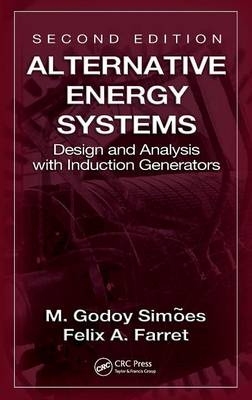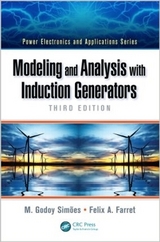
Alternative Energy Systems
Crc Press Inc (Verlag)
978-1-4200-5532-0 (ISBN)
- Titel erscheint in neuer Auflage
- Artikel merken
New perspectives on using induction generators in alternative energy technologies Durable and cost-effective, induction power generators have undergone numerous improvements that make them an increasingly attractive option for renewable energy applications, particularly for wind and hydropower generation systems. From fundamental concepts to the latest technologies, Alternative Energy Systems: Design and Analysis with Induction Generators, Second Edition provides detailed and accurate coverage of all aspects related to the design, operation, and overall analysis of such systems.
Placing a greater emphasis on providing clear, precise, and succinct explanations, this second edition features new, revised, and updated content as well as figures, tables, equations, and examples. Each chapter introduces a multi-step, chapter-length problem relating the material to a real application. The solution appears at the end of the chapter, along with additional practice problems and references.
New Material in This Edition:
Updated definitions for generated power and efficiency
Technological advances, such as new applications using doubly-fed induction generators
New methodologies, such as the magnetization curve representation for induction generators
Additional focus on renewable energy applications such as sea, wind, and hydropower systems
Totally re-written and updated chapter covering doubly-fed induction generators
Alternative Energy Systems provides the tools and expertise for advanced students and professionals in electrical, mechanical, civil, and environmental engineering involved in the development of power plants.
";
Colorado School of Mines, Golden, USA UFSM-CT-DPEE, Santa Maria, Brazil
PRINCIPLES OF ALTERNATIVE SOURCES OF ENERGY AND ELECTRIC GENERATION
Legal Definitions
Principles of Electrical Conversion
Basic Definitions of Electrical Power
Characteristics of Primary Sources
Characteristics of Remote Industrial, Commercial, Residential Sites and Rural Energy
Selection of the Electric Generator
Interfacing Primary Source, Generator, and Load
Example of a Simple Integrated Generating and Energy-Storing System
STEADY-STATE MODEL OF THE INDUCTION GENERATOR
Interconnection and Disconnection of the Electric Distribution Network
Robustness of the Induction Generator
Classical Steady-State Representation of the Asynchronous Machine
Generated Power
Induced Torque
Representation of the Induction Generator Losses
Measurement of Induction Generator Parameters
Peculiarities of the Induction Machine Working as a Generator Interconnected to the Distribution Network
High Efficiency Induction Generator
Doubly-Fed Induction Generator
TRANSIENT MODEL OF THE INDUCTION GENERATOR
Induction Machine in Transient State
State Space-Based Induction Generator Modeling
Partition of SEIG State Matrix with an RLC Load
Generalization of the Association of Self-Excited Generators
Relationship between Torque and Shaft Oscillation
Transient Simulation of Induction Generators
Using This Chapter to Solve Typical Problems
SELF-EXCITED INDUCTION GENERATOR
Performance of the Self-Excited Induction Generator
Magnetizing Curves and Self-Excitation
Mathematical Description of the Self-Excitation Process
Series Capacitors and Composed Excitation of the Induction Generator
GENERAL CHARACTERISTICS OF THE INDUCTION GENERATOR
Torque–Speed Characteristics of the Induction Generator
Power versus Current Characteristics
Rotor Power Factor as a Function of Rotation
Nonlinear Relationship between Air-Gap Voltage Vg and Magnetizing Current Im
Example of Determination of the Magnetizing Curve and Magnetizing Reactance
Voltage Regulation
Characteristics of Rotation
CONSTRUCTION FEATURES OF THE INDUCTION GENERATOR
Electromechanical Considerations
Optimization of the Manufacturing Process
Types of Design
Sizing the Machine
Efficiency Issues
POWER ELECTRONICS FOR INTERFACING INDUCTION GENERATORS
Power Semiconductor Devices
Power Electronics and Converter Circuits
DC to DC Conversion
AC to DC Conversion
DC to AC Conversion
Direct AC to AC Conversion
SCALAR CONTROL FOR INDUCTION GENERATORS
Scalar Control Background
Scalar Control Schemes
VECTOR CONTROL FOR INDUCTION GENERATORS
Vector Control for Induction Generators
Axis Transformation
Space Vector Notation
Field-Oriented Control
OPTIMIZED CONTROL FOR INDUCTION GENERATORS
Why Optimize Induction-Generator-Based Renewable Energy Systems?
Optimization Principles: Optimize Benefit or Minimize Effort
Application of Hill Climbing Control (HCC) for Induction Generators
HCC-Based Maximum Power Search
Fuzzy Logic Control (FLC)-Based Maximum Power Search
Chapter Summary
DOUBLY-FED INDUCTION GENERATOR
Features of DFIG
Sub- and Supersynchronous Modes
Operation of DFIG
Interconnected and Stand-Alone Operation
Field-Oriented Control of DFIG
Active-Reactive Power Control for a Doubly-Fed Induction Generator
Stand-Alone Doubly-Fed Induction Generator
SIMULATION TOOLS FOR THE INDUCTION GENERATOR
Design Fundamentals of Small Power Plants
Simplified Design of Small Wind Power Plants
Simulation of Self-Excited Induction Generator in PSpice
Simulation of Self-Excited Induction Generator in Pascal
Simulation of Steady-State Operation of an Induction Generator Using Microsoft Excel
Simulation of Vector-Controlled Schemes Using MATLAB / Simulink
Simulation of Self-Excited Induction Generator in PSim
Simulation of Self-Excited Induction Generator in MATLAB
Simulation of Self-Excited Induction Generator in C
APPLICATIONS OF INDUCTION GENERATORS IN ALTERNATIVE SOURCES OF ENERGY
Voltage and Frequency Control of Induction Generators
Application of Electronic Load Controllers
Wind Power with Variable Speed
Run-of-River Hydro Generation
Wave and Tidal Powers
Stirling Engine Power and Co-Generation
Danish Concept
Doubly-Fed Induction Generator (DFIG)
Pump-as-Turbine (PAT)
Pumped-Storage Plants or Back-Pumping
Constant Frequency, Constant Speed, and Constant Power
Linear Induction Generator
Stand-Alone Operation
Distributed Generation
ECONOMICS OF INDUCTION GENERATOR-BASED RENEWABLE SYSTEMS
Optimal and Market Price of Energy in a Regulatory Environment
World Climate Change Related to Power Generation
Appraisal of Investment
Concept Selection and Optimization of Investment
Future Directions
APPENDIX A: Introduction to Fuzzy Logic
APPENDIX B: C Statements for Simulation of a Self-Excited Induction Generator
APPENDIX C: Pascal Statements for Simulation of a Self-Excited Induction Generator
APPENDIX D: Power Tracking Curve-Based Algorithm for Wind Energy Systems
Index
*Each chapter includes an introductory Scope of the Chapter as well as Problems and References sections
| Erscheint lt. Verlag | 28.12.2007 |
|---|---|
| Reihe/Serie | Power Electronics and Applications Series |
| Zusatzinfo | 34 Tables, black and white; 248 Illustrations, black and white |
| Verlagsort | Bosa Roca |
| Sprache | englisch |
| Maße | 156 x 234 mm |
| Gewicht | 771 g |
| Themenwelt | Technik ► Elektrotechnik / Energietechnik |
| ISBN-10 | 1-4200-5532-1 / 1420055321 |
| ISBN-13 | 978-1-4200-5532-0 / 9781420055320 |
| Zustand | Neuware |
| Haben Sie eine Frage zum Produkt? |
aus dem Bereich



